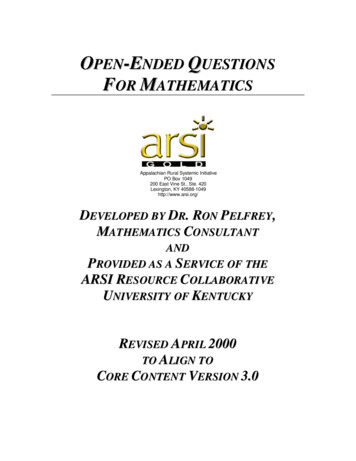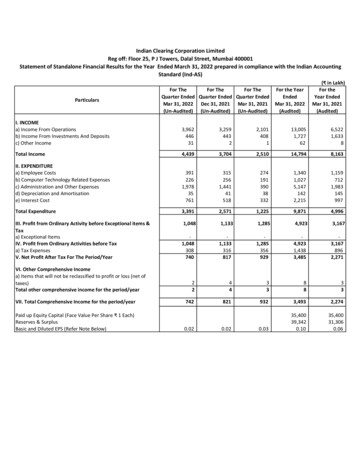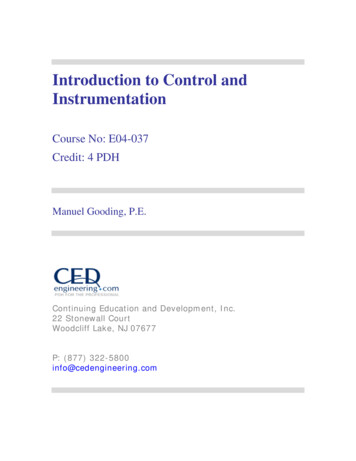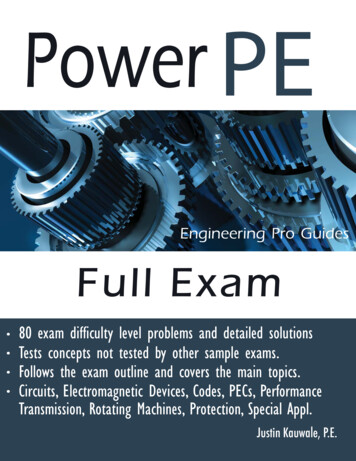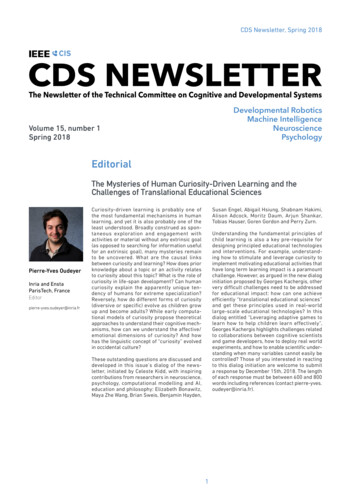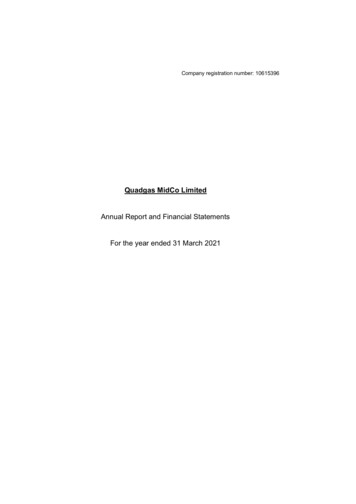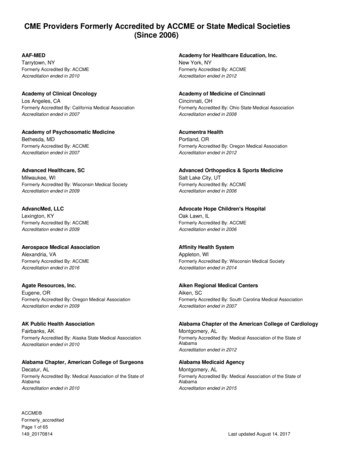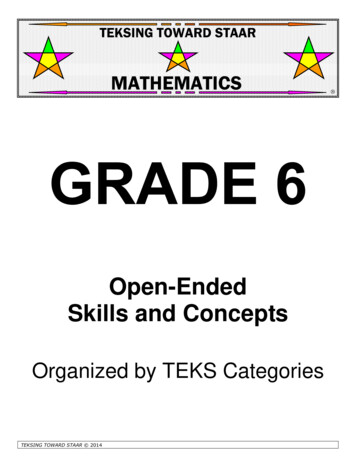
Transcription
TEKSING TOWARD STAARMATHEMATICSOpen-EndedSkills and ConceptsOrganized by TEKS CategoriesTEKSING TOWARD STAAR 2014
GRADE 6 OPEN-ENDED SKILLS and CONCEPTSOVERVIEWThis document was created with all students in mind and provides teachers with sets of 5 openended questions to assess student mastery of TEKS assessed on STAAR. Each set of questionsin this document is correlated to a specific Category and TEKS. These materials can be utilizedfor guided practice, independent practice, or homework. These materials can be utilized with awhole class, small groups, and/or tutorial settings.NOTE: There is no answer key provided for the Skills and Concepts problems as the authors’philosophy is that each teacher create a personalized Solutions Manual so the teacher becomesmore familiar with the Revised TEKS and assessment of the Revised TEKS, as well as formulatesvarious solution strategies for each question.AUTHORS’ VISION FOR IMPLEMENTATIONSKILLS AND CONCEPTS Skills and Concepts are open-ended questions that are organized by individual TEKS. EachSkills and Concepts includes 5 open-ended questions. The teacher sets the time limit prior to the students beginning the Skills and Concepts if thematerial is being utilized for independent practice. Students work on Skills and Concepts in partner pairs even during independent practice.Partner pairs are given specific “share questions” on the Skills and Concepts. The processthat should be followed by all partner pairs is to complete the question(s) they are assignedto share, and then work on the other questions until time is called. The teacher calls time and the partner pairs guide class discussion on their “share questions”assignments. Students who did not complete the Skills and Concepts prior to the time limitmay record on their individual papers during the discussion time but must record in adifferent color. A Skills and Concepts should NOT be sent home for homework until the majority of the classhas demonstrated mastery of the TEKS addressed.TEKSING TOWARD STAAR 2014Page 1
TEKSING TOWARD STAARGRADE 6 OPEN ENDED SKILLS AND CONCEPTSTable of ContentsMathematical Process StandardsThese student expectations will not be listed separately. They will be incorporatedinto assessments for TEKS in other categories since the application of mathematicalprocess standards is part of each knowledge statement for all other TEKS.6.(1) Mathematical Process StandardsThe student uses mathematical processes to acquire and demonstrate 1(D)6.1(E)6.1(F)6.1(G)STUDENT EXPECTATIONapply mathematics to problems arising in everyday life, society, and the workplaceuse a problem-solving model that incorporates analyzing given information, formulatinga plan or strategy, determining a solution, justifying the solution, and evaluating theproblem-solving process and the reasonableness of the solutionselect tools, including real objects, manipulatives, paper and pencil, and technology asappropriate, and techniques, including mental math, estimation, and number sense asappropriate, to solve problemscommunicate mathematical ideas, reasoning, and their implications using multiplerepresentations, including symbols, diagrams, graphs, and language as appropriatecreate and use representations to organize, record, and communicate mathematicalideasanalyze mathematical relationships to connect and communicate mathematical ideasdisplay, explain, and justify mathematical ideas and arguments using precisemathematical language in written or oral communicationTEKSING TOWARD STAAR 2014Page 1
TEKSING TOWARD STAARGRADE 6 OPEN ENDED SKILLS AND CONCEPTSTable of ContentsCategory 1: Number and Operations6.(2) Number and OperationsThe student applies mathematical process standards to represent and use rational numbers in avariety of forms.STAARStandardTEKSSTUDENT EXPECTATIONSupporting 6.2(A) classify whole numbers, integers, and rational numbers using a visualrepresentation such as a Venn diagram to describe relationships between sets ofnumbersSupporting 6.2(B) identify a number, its opposite, and its absolute valueSupporting 6.2(C) locate, compare, and order integers and rational numbers using a number lineReadiness 6.2(D) order a set of rational numbers arising from mathematical and real-world contextsSupporting 6.2(E) extend representations for division to include fraction notation such as a/brepresents the same number as a b where b 06.(3) Number and OperationsThe student applies mathematical process standards to represent addition, subtraction,multiplication, and division while solving problems and justifying solutions.STAARStandardTEKSSTUDENT EXPECTATIONSupporting 6.3(A) recognize that dividing by a rational number and multiplying by its reciprocalresult in equivalent values.Supporting 6.3(B) determine, with and without computation, whether a quantity is increased ordecreased when multiplied by a fraction, including values greater than or lessthan oneSupporting 6.3(C) represent integer operations with concrete models and connect the actionswith the models to standardized algorithmsReadiness 6.3(D) add, subtract, multiply, and divide integers fluentlyReadiness 6.3(E) multiply and divide positive rational numbers fluentlyTEKSING TOWARD STAAR 2014Page 2
TEKSING TOWARD STAARGRADE 6 OPEN ENDED SKILLS AND CONCEPTSTable of ContentsCategory 2: Proportionality6.(4) ProportionalityThe student applies mathematical process standards to develop an understanding ofproportional relationships in problem situations.STAARStandardTEKSSTUDENT EXPECTATIONSupporting 6.4(A) compare two rules verbally, numerically, graphically, and symbolically in theReadiness 6.4(B)Supporting 6.4(C)Supporting 6.4(D)Readiness 6.4(E)Supporting 6.4(F)Readiness 6.4(G)Readiness 6.4(H)form of y ax or y x a in order to differentiate between additive andmultiplicative relationshipsapply qualitative and quantitative reasoning to solve prediction andcomparison of real-world problems involving ratios and ratesgive examples of ratios as multiplicative comparisons of two quantitiesdescribing the same attribute.give examples of rates as the comparison by division of two quantitieshaving different attributes, including rates as quotientsrepresent ratios and percents with concrete models, fractions, and decimals.represent benchmark fractions and percents such as 1%, 10%, 25%, 331/3%, and multiples of these values using 10 by 10 grids, strip diagrams,number lines, and numbersgenerate equivalent forms of fractions, decimals, and percents using realworld problems, including problems that involve moneyconvert units within a measurement system, including the use of proportionsand unit ratesProportionality6.(5) ProportionalityThe student applies mathematical process standards to solve problems involving proportionalrelationships.STAARStandardTEKSSTUDENT EXPECTATIONSupporting 6.5(A) represent mathematical and real-world problems involving ratios and ratesusing scale factors, tables, graphs, and proportionsReadiness 6.5(B) solve real-world problems to find the whole given a part and the percent, tofind the part given the whole and the percent, and to find the percent giventhe part and the whole, including the use of concrete and pictorial modelsSupporting 6.5(C) use equivalent fractions, decimals, and percents to show equal parts of thesame wholeTEKSING TOWARD STAAR 2014Page 3
TEKSING TOWARD STAARGRADE 6 OPEN ENDED SKILLS AND CONCEPTSTable of ContentsCategory 3: Expressions, Equations, and Relationships6.(6) Expressions, Equations, and RelationshipsThe student applies mathematical process standards to use multiple representations to describealgebraic relationships.STAARStandardTEKSSTUDENT EXPECTATIONSupporting 6.6(A) identify independent and dependent quantities from tables and graphsSupporting 6.6(B) write an equation that represents the relationship between independent anddependent quantities from a tableReadiness 6.6(C) represent a given situation using verbal descriptions, tables, graphs, andequations in the form y kx or y x bExpressions, Equations, and Relationships6.(7) Expressions, Equations, and RelationshipsThe student applies mathematical process standards to develop concepts of expressions andequations.STAARStandardTEKSSTUDENT EXPECTATIONSupporting 6.7(A) generate equivalent numerical expressions using order of operations, including wholenumber exponents and prime factorizationReadiness 6.7(B) distinguish between expressions and equations verbally, numerically, andalgebraicallySupporting 6.7(C) determine if two expressions are equivalent using concrete models, pictorial models,and algebraic representationsSupporting 6.7(D) generate equivalent expressions using the properties of operations: inverse, identity,commutative, associative, and distributive propertiesExpressions, Equations, and Relationships6.(8) Expressions, Equations, and RelationshipsThe student applies mathematical process standards to use geometry to represent relationshipsand solve problems.STAARStandardTEKSSTUDENT EXPECTATIONSupporting 6.8(A) extend previous knowledge of triangles and their properties to include thesum of angles of a triangle, the relationship between the lengths of sides andmeasures of angles in a triangle, and determining when three lengths form atriangleSupporting 6.8(B) model area formulas for parallelograms, trapezoids, and triangles bydecomposing and rearranging parts of these shapesSupporting 6.8(C) write equations that represent problems related to the area of rectangles,parallelograms, trapezoids, and triangles and volume ofright rectangular prisms where dimensions are positive rational numbersReadiness 6.8(D) determine solutions for problems involving the area of rectangles,parallelograms, trapezoids, and triangles and volume of rightrectangular prisms where dimensions are positive rational numbersTEKSING TOWARD STAAR 2014Page 4
TEKSING TOWARD STAARGRADE 6 OPEN ENDED SKILLS AND CONCEPTSTable of ContentsCategory 3: Expressions, Equations, and Relationships6.(9) Expressions, Equations, and RelationshipsThe student applies mathematical process standards to use equations and inequalities torepresent situations.STAARStandardTEKSSTUDENT EXPECTATIONSupporting 6.9(A) write one-variable, one-step equations and inequalities to representconstraints or conditions within the problemSupporting 6.9(B) represent solutions for one-variable, one-step equations and inequalities onnumber linesSupporting 6.9(C) write corresponding real-world problems given one-variable, one-stepequations or inequalitiesExpressions, Equations, and Relationships6.(10) Expressions, Equations, and RelationshipsThe student applies mathematical process standards to use equations and inequalities to solveproblems.STAARStandardTEKSSTUDENT EXPECTATIONReadiness 6.10(A) model and solve one-variable, one-step equations and inequalities thatrepresent problems, including geometric conceptsSupporting 6.10(B) determine if the given value(s) make(s) one-variable, one-step equationsor inequalities trueTEKSING TOWARD STAAR 2014Page 5
TEKSING TOWARD STAARGRADE 6 OPEN ENDED SKILLS AND CONCEPTSTable of ContentsCategory 4: Measurement and Data6.(11) Measurement and DataThe student applies mathematical process standards to use coordinate geometry to identifylocations on a plane.STAARStandardTEKSReadiness6.11(A)STUDENT EXPECTATIONGraph points in all four quadrants using ordered pairs of rationalnumbersMeasurement and Data6.(12) Measurement and DataThe student applies mathematical process standards to use numerical or graphicalrepresentations to analyze problems.STAARStandardTEKSSTUDENT sent numeric data graphically, including dot plots, stem-and-leaf plots,histograms, and box plotsuse the graphical representation of numeric data to describe the center, spreadand the shape of the data distributionsummarize numeric data with numerical summaries, including the mean andmedian (measures of center) and the range and interquartile range (IQR)(measures of spread) and use these summaries to describe the center, spread,and shape of data distributionsummarize categorical data with numerical and graphical summaries, includingthe mode, the percent of values in each category (relative frequency table), andthe percent bar graph, and use these summariesto describe the data ement and Data6.(13) Measurement and DataThe student applies mathematical process standards to use numerical or graphicalrepresentations to solve problems.STAARStandardTEKSSTUDENT ret numeric data summarized in dot plots, stem-and-leaf plots, histogramsand box plotsdistinguish between situations that yield data with and without variabilityTEKSING TOWARD STAAR 2014Page 6
TEKSING TOWARD STAARGRADE 6 OPEN ENDED SKILLS AND CONCEPTSTable of ContentsCategory 5: Personal Financial Literacy6.(14) Personal Financial LiteracyThe student applies mathematical processes standards to develop an economic way of thinkingand problem solving useful in one’s life as a knowledgeable consumer and investor.STAARTEKSSTUDENT EXPECTATIONStandardSupporting 6.14(A)compare the features and costs of a checking account and a debit cardoffered by different local financial institutionsSupporting 6.14 (B) distinguish between debit cards and credit cardsSupporting 6.14 (C) balance a check register that includes deposits, withdrawals, andtransfersNot Tested 6.14 (D) explain why it is important to establish a positive credit historySupporting 6.14 (E) describe the information in a credit report and how long it is retainedSupporting 6.14 (F) describe the value of credit reports to borrowers and to lendersSupporting 6.14 (G) explain various methods to pay for college, including through savings,grants, scholarships, student loans, and work-studySupporting 6.14 (H) compare the annual salary of several occupations requiring various levelsof post-secondary education or vocational training and calculate theeffects of the different annual salaries on lifetime incomeTEKSING TOWARD STAAR 2014Page 7
TEKSING TOWARD STAARMATHEMATICS GRADE 6Open Ended Skills andConceptsTEKS CATEGORY 1Numbers and OperationsTEKSING TOWARD STAAR 2014
TEKSING TOWARD STAARMATHEMATICSGRADE 6Open Ended Skills andConceptsTEKS CATEGORY 16.2CTEKSING TOWARD STAAR 2014
STAAR Category 1Grade 6 MathematicsTEKS 6.2C6.2C Skills and Concepts 11. Fill in the blanks with “left of” or “right of” to indicate the position of the first number in relation to thesecond number on a number line.3.2 is 313412is 445 11is 432. List 2 numbers that are near to but left of the given numbers on a number line.and are near to but left of3.5and are near to but left of 21.63. Name 2 numbers that are near to but right of the given numbers on a number line.and are near to but right of 2.05.and are near to but right of 7.48.4. Order3 351,,andfrom least to greatest. Show your work to support your answer.8 4 162, , ,Show the numbers on a number line.0½15. Order 1.25, 1.38, 1.33, and 1.29 from greatest to least. Explain how you made the decision for theorder you listed., , ,Explanation:TEKSING TOWARD STAAR 2014Page 1
STAAR Category 1Grade 6 MathematicsTEKS 6.2C6.2C Skills and Concepts 21. In each pair of integers, circle the number that would be left of the other number on a number line. 5 8 158 300 7531422. Circle the number in each list that is closest to 3 on a number line. 235 2.783132.982123.123. Four golf scores are 3, 4, 5, and 1 . In golf the smaller score is the better score. Which score isthe best score of the four scores?Graph the four scores on a number line.33314. Order 3 , 3, 4 and 2 from least to greatest. Show your work to support your answer.51042, , ,Graph the four numbers on a number line.5. Order 35.5, 31.8, 31.3, and 34.9 from greatest to least., , ,Graph the four numbers on a number line.TEKSING TOWARD STAAR 2014Page 1
STAAR Category 1Grade 6 MathematicsTEKS 6.2C6.2C Skills and Concepts 31. Place a , , or between the following pairs of rational numbers to make a true statement.3.1423.25122.5 7 1032 322. Order the set of rational numbers from least to greatest. Show your work to support your answer. 5.75 512 4.75 414Graph the four numbers on a number line.-6-5-43. Write a number on the blank line so the list is ordered from greatest to least.18.918.818234. Plot each number in the set below on the number line.2.93.22.42122.62.7522333.52.85. Circle the numbers below that are between 3 and 3.5 on a number line. 3.9TEKSING TOWARD STAAR 2014 3.2 314 3.75 315 3.1 3.55Page 1
STAAR Category 1Grade 6 MathematicsTEKS 6.2C6.2C Skills and Concepts 41. Place a , , or between the following pairs of numbers so that the statement is true.13.4213.04142.5 17 11 33 312. Circle the number in each list that is closest to 5 on a number line. 535 5.785134.94355.213, 3.4, 2 , and 3.3 feet long. Order the lengths from24Show your work to support your answers3. Mrs. King has four pieces of yarn. They are 2longest to shortest., , ,4. Mary ordered four numbers from least to greatest. Her ordered list is1, 0.3,53 1,.4 2Do you agreeor disagree with her ordered list? Justify your answer.5. Order 35.5, 3523, 34.9 and 34from greatest to least.54, , ,Plot the numbers on the number line.34.7TEKSING TOWARD STAAR 20143535.5Page 1
TEKSING TOWARD STAARMATHEMATICSGRADE 6Open Ended Skills andConceptsTEKS CATEGORY 16.3ETEKSING TOWARD STAAR 2014
STAAR Category 2Grade 6 MathematicsTEKS 6.3E6.3E Skills and Concepts 11. Find the following products.5 9093.2 0.5458 3.57.5 1213 40 8 33138 4502. Find the following quotients.1 1 5 20.32 0.4472 0.0917.5 243 782 12313of the marbles to Marvin and of the marbles to Leroy. He kept58the remaining marbles. How many marbles did each boy have?3. Jonas has 40 marbles. He gave11of the ribbons to Sherry. She gave of the remaining38ribbons to Marcy. She kept the remaining ribbons. How many ribbons did each girl have?4. Betty has 36 hair ribbons. She gave5. Describe in your own words how to divide fractions.TEKSING TOWARD STAAR 2014Page 1
STAAR Category 2Grade 6 MathematicsTEKS 6.3E6.3E Skills and Concepts 21. Find the following products.1 90182.2 0.4324 1.53.5 0.123 7 8 241.38 4502. Find the following quotients.1 15 5 141.32 0.447.2 0.97.5 3. The math quiz has 45 problems. Martha got3241 1 8 83 2427of the problems correct. How many problems did9Martha get incorrect?4. Beau has 36 marbles. He gave his brother4of them. How many marbles did each boy have?95. Describe in your own words how to divide a fraction and a decimal.TEKSING TOWARD STAAR 2014Page 1
TEKSING TOWARD STAARMATHEMATICS GRADE 6Open Ended Skills andConceptsTEKS CATEGORY 2ProportionalityTEKSING TOWARD STAAR 2014
TEKSING TOWARD STAARMATHEMATICSGRADE 6Open Ended Skills andConceptsTEKS CATEGORY 26.4CTEKSING TOWARD STAAR 2014
STAAR Category 1Grade 6 MathematicsTEKS 6.4C6.4C Skills and Concepts 1Complete the following statements.1. If a 6 and c 15 , then c is times a.2. If a garden contained 20 tomato plants and 18 pepper plants, then the number of tomato plants istimes the number of pepper plants.3. A recipe requires 2 cups of sugar and 3.5 cups of flour. The number of cups of sugar in the recipe istimes the number of cups of flour.4.If a flower bouquet contained 8 roses and 12 carnations, then the number of roses in the bouquet istimes the number of carnations.5. The length of a rectangle is 15 centimeters and the width is 12 centimeters. The length of therectangle is times the width of the rectangle.TEKSING TOWARD STAAR 2014Page 1
STAAR Category 1Grade 6 MathematicsTEKS 6.4C6.4C Skills and Concepts 2Complete the following statements.1. If b 60 and c 25 , then c is times b.2. If a garden contained 12 squash plants and 10 pepper plants, then the number of squash plants istimes the number of pepper plants.3. A company logo has 15 red stripes and 10 blue stripes.The number of red stripes istimes the number of blue stripes in the logo.4. If a bag of marbles has 15 red, 15 blue, 10 green, and 9 white marbles. The number of red marbles inthe bag is times the number of green marbles. The number of white marbles istimes the number of blue marbles in the bag.5. The length of a rectangle is 36 centimeters and the width is 16 centimeters. The length of therectangle is times the width of the rectangle.TEKSING TOWARD STAAR 2014Page 1
TEKSING TOWARD STAARMATHEMATICSGRADE 6Open Ended Skills andConceptsTEKS CATEGORY 26.5CTEKSING TOWARD STAAR 2014
STAAR Category 1Grade 6 MathematicsTEKS 6.5C6.5C Skills and Concepts 11. If 50% of a circle is shaded, what fractional part of the circle is NOT shaded?2. Shade the models below to represent2, 0.4, and 40%.5What do you notice about the shaded part of each model?3. Shade the model below to show 37.5%.What fractional part did you shade?TEKSING TOWARD STAAR 2014Page 1
STAAR Category 1Grade 6 Mathematics4. What decimal and percent are equivalent toShade the model to represent5. Shade this model to representTEKSING TOWARD STAAR 2014TEKS 6.5C7?207.207.20Page 2
STAAR Category 1Grade 6 MathematicsTEKS 6.5C6.5C Skills and Concepts 21. If 35% of a rectangle is shaded, what fractional part of the rectangle is NOT shaded?2. Shade the models below to represent3, 0.3, and 30%.10What do you notice about the shaded part of each model?3. Shade the model below to show5. (Hint: Each eighth represents how many sixteenths?)16What percent did you shade?TEKSING TOWARD STAAR 2014Page 1
STAAR Category 1Grade 6 Mathematics4. What decimal and percent are equivalent toShade the model to representTEKS 6.5C9?409.4011. (Hint: Would it help to divide one of the smaller rectangles into16fourths? If you did, what part of the whole is each of those smallest rectangles? )5. Shade this model to representTEKSING TOWARD STAAR 2014Page 2
TEKSING TOWARD STAARMATHEMATICS GRADE 6Open Ended Skills andConceptsTEKS CATEGORY 3Expressions, Equations,and RelationshipsTEKSING TOWARD STAAR 2014
TEKSING TOWARD STAARMATHEMATICSGRADE 6Open Ended Skills andConceptsTEKS CATEGORY 36.6ATEKSING TOWARD STAAR 2014
STAAR Category 2Grade 6 MathematicsTEKS 6.6A6.6A Skills and Concepts 11. In your own words, describe what independent and dependent quantities are in a relationship.2. The table below shows the relationship between the number of oranges and the number of boxes oforanges.Number of BoxesNumber of Oranges35447261088144The number of depends upon the number of .The independent quantity is .The dependent quantity is .3. The area of a rectangle with a width of 8 units can be expressed as A 8 x , where x represents thelength of the rectangle. Complete the table below with values that represent the length and the areaof this rectangle. Label the title of each row.What is the dependent quantity in this relationship?On which row of the table should the dependent quantity be located?If you were graphing these values on a grid, which axis would be the vertical axis?4. The number of nickels in a coin collection is twice the number of dimes in the collection. Complete thetable below to show possible number of nickels and dimes in the collection. Label the rows of thetable.What is the independent quantity in this relationship?On which row of the table should the independent quantity be located?If you were graphing these values on a grid, which axis would be the horizontal axis?TEKSING TOWARD STAAR 2014Page 1
STAAR Category 2Grade 6 MathematicsTEKS 6.6A5. The length of a rectangle is 2 inches more than the width. Create a table to show possible values forthe dimensions of the rectangle. Graph these values on the grid below.l161514131211109876543210TEKSING TOWARD STAAR 2014123 456 789 10 11 12 13 14 15 16wPage 2
STAAR Category 2Grade 6 MathematicsTEKS 6.6A6.6A Skills and Concepts 21. In a table, where should the dependent quantity be located?On a graph, where should the dependent quantity be located?2. The table below shows the relationship between the inches and feet.Number of InchesNumber of Feet3634846051089The number of depends upon the number of .The independent quantity is .The dependent quantity is .Would it be reasonable that the number of inches could be the bottom row and the number of feet bethe top row in this situation?If so, what does that mean about this situation?3. The area of a triangle with a base of 8 units can be expressed as A 4 x , where x represents theheight of the triangle. Complete the table below with values that represent the height and the area ofthis triangle. Label the title of each row.What is the dependent quantity in this relationship?On which row of the table should the dependent quantity be located?If you were graphing these values on a grid, which quantity would be represented by the vertical axis?TEKSING TOWARD STAAR 2014Page 1
STAAR Category 2Grade 6 MathematicsTEKS 6.6A4. Colson collects baseball and football sports cards. The number of baseball cards he has is 35 morethan the number of football cards. Complete the table below to show possible numbers of the baseballand football cards he has collected. Label the rows of the table.What is the independent quantity in this relationship?On which row of the table should the independent quantity be located?If you were graphing these values on a grid, which quantity would be represented by the horizontalaxis?5. The length of a rectangle is 3 inches more than twice the width. Create a table to show possible valuesfor the dimensions of the rectangle. Graph these values on the grid below.l161514131211109876543210TEKSING TOWARD STAAR 2014123 456 789 10 11 12 13 14 15 16wPage 2
TEKSING TOWARD STAARMATHEMATICSGRADE 6Open Ended Skills andConceptsTEKS CATEGORY 36.8DTEKSING TOWARD STAAR 2014
STAAR Category 3Grade 6 MathematicsTEKS 6.8D6.8D Skills and Concepts 21. A rectangular prism has a base area of 42 square inches. The volume of the prism is 356 cubic inches.What is the height of the prism? Show your work.h inchesV 356 cu in.Area of Base: 42 square inches2. One edge of a cube is 12 centimeters. What is the area of the top of the cube? Show your work.12 cmWhat is the volume of the cube? Show your work.3. The parallelogram below has a height of 8.5 units and a base of 25.5 units. What is the area of theparallelogram? Show your work.25.5 units8.5 unitsTEKSING TOWARD STAAR 2014Page 1
STAAR Category 3Grade 6 MathematicsTEKS 6.8D4. An isosceles triangle has an altitude to the base drawn. Find the area of the shaded right triangle.Show your work.22 units46 units5. Find the area of the composite figure below if CF 6 and AE ED 8.BCAETEKSING TOWARD STAAR 2014FDPage 2
STAAR Category 3Grade 6 MathematicsTEKS 6.8D6.8D Skills and Concepts 11. Find the area of the trapezoid below. Show your work.10 units8.5 units5 units2. Find the area of the right triangles shown below. Show your work.6 units3.3 units17.4 units6 units3. The area of a parallelogram is 180 square units. The base of the parallelogram is 24 units.24 unitsh unitsWhat is the height of the parallelogram? Show your work.TEKSING TOWARD STAAR 2014Page 1
STAAR Category 3Grade 6 Mathematics4. The area of the triangle is 176 square units. What is the height of the triangle?TEKS 6.8DShow your workh units14 units30 units5. The area of the triangle below is 120 square units. What will be the entire length of the base of thetriangle? Show your work.8 units2x unitsTEKSING TOWARD STAAR 2014x unitsPage 2
TEKSING TOWARD STAARMATHEMATICS GRADE 6Open Ended Skills andConceptsTEKS CATEGORY 4Measurement and DataTEKSING TOWARD STAAR 2014
TEKSING TOWARD STAARMATHEMATICSGRADE 6Open Ended Skills andConceptsTEKS CATEGORY 46.11ATEKSING TOWARD STAAR 2014
STAAR Category 3Grade 6 MathematicsTEKS 6.11A6.11A Skills and Concepts 11. List 5 ordered pairs that would be located in Quadrant I when graphed on a coordinate plane.2. List 5 ordered pairs that would be located in Quadrant IV when graphed on a coordinate plane.3. List 5 ordered pairs that would be located on the y-axis when graphed on a coordinate plane.4. List 5 ordered pairs that would be located in Quadrant II when graphed on a coordinate plane.5. List 5 ordered pairs that would be located on the x-axis when graphed on a coordinate plane.TEKSING TOWARD STAAR 2014Page 1
STAAR Category 3Grade 6 MathematicsTEKS 6.11A6.11A Skills and Concepts 21. Identify which Quadrant or which axis each ordered pair would be located in or on when graphed.(3, 6)(0, 5)(3, 0)(3, 10 )(1.7, 4 )( 4 , 5( 2.3 , 4 )1)2( 4 , 0)2. Circle the ordered pairs that have an x-coordinate and a y-coordinate that are opposites.(3, 3)(0, 0)(1, 1 )( 4 , 4)(3, 3 )( 2.5 , 2.5 )( 1 , 1 )( 5 , 5)3. Circle the ordered pairs that have an x-coordinate greater than 1 and a y-coordinate less than 2 .(3, 3 )(0, 0)(2, 1 )( 4 , 4 )(2, 2 )(0, 3 )(6, 7 )( 5 , 5)Below each ordered pair, label the Quadrant or axis the point would be located in or on.4. Plot the points from Question 3 on the coordinate grid below. Label each point with its ordered pair.y987654321-9 -8 –7 -6 -5 -4 -3 -2 -1-1123 456 789x-2-3-4-5-6-7-8-9TEKSING TOWARD STAAR 2014Page 1
STAAR Category 3Grade 6 MathematicsTEKS 6.11A5. Plot the ordered pairs from Question 1 on the grid below. Label each point with its order
Skills and Concepts includes 5 open-ended questions. The teacher sets the time limit prior to the students beginning the Skills and Concepts if the material is being utilized for independent practice. Students work on Skills
